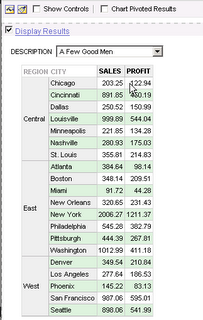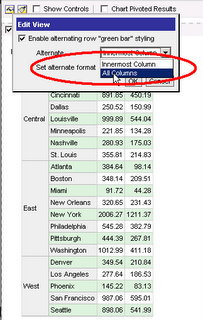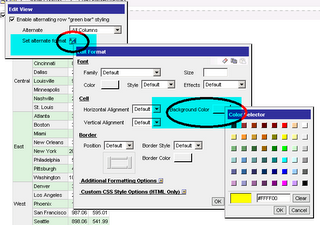Thanks for the introduction Abhinav...:)
I will start out with highlighting some of the advantages of using the OracleBI Spreadsheet Add-in. They might not all be quite obvious, but you will appreciate them when you use the product.
Ease of use.
- It installs really easily. Just run the .exe file, walk through the wizard and you are done. Start Excel, and you will see the OracleBI menu.
- We have tried to make the product intuitive to use, so the user can use familiar Excel functions. More on this below.
Formatting and printing.
- You have finegrained control over the appearance of the data. Essentially, you have full control over the format for each individual cell, as you do in Excel
- You can move the Query area around within the sheet using cut/paste, to make space for Charts, formulas etc.
- You can then print the worksheet as a nicely formatted report. Although you don't have pixel perfect control, it is good enough for most purposes, and you still have live, refreshable data.
Extended analysis.
- Add Excel formulas into the Query area just by inserting rows and columns. The add-in will preserve the formulas even when drilling, provided that the cell references are still there.
- You can create formulas that combine data from OLAP with data from other sheets, which could be external data. This is not possible with the built-in Calculation Wizard.
- On the other hand, the Calcuation Wizard enables you to create easily calculations such as 'Variance from Last year' without the need for downloading last years data to Excel first. The calculation runs in the OLAP Server where the data is stored, making this possible.
Using VBA.
- The data is written into the Excel cells, just as if you typed it in, so if you have VBA skills, you can perform additional processing of data by looping through the cells, comparing with other data, creating charts of the data etc. We have added support for some new VBA calls in the upcoming release that will help you with this type of thing.
Multiple queries and databases.
- It is possible to create multiple queries in a Worksheet, and even multiple queries against multiple databases in a workbook. This is a quite unique feature.
- In the new release there is be a Refresh Workbook/ Refresh Worksheet feature to make it easier to reconnect multiple queries. If there are multiple connections, the login dialog will be displayed as needed.
Write-back to Oracle OLAP cubes.
- Write-back has been added in the upcoming release. The OracleBI Spreadsheet Add-in is currently the only Oracle product that does this, short of building your own java application with BI Beans and JDeveloper. This is not trivial, as there are lots of things you have to take into account in designing your cubes and your workbooks, but this is a major feature.







